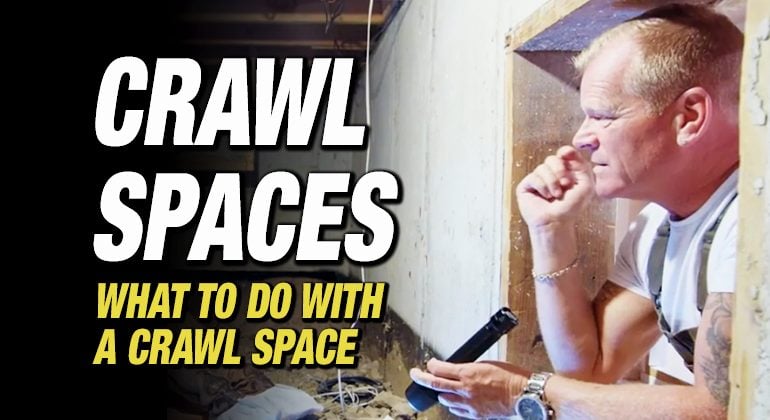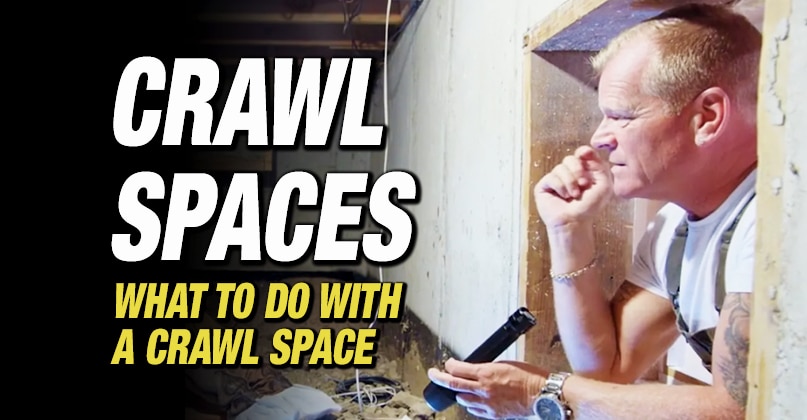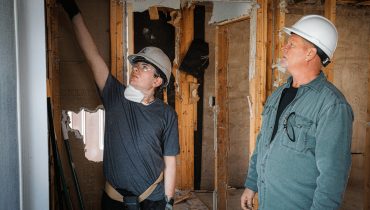For years I’ve been talking about protecting your home from the outside-in. And that includes protecting it against water intrusion. You always want water to move AWAY from your home’s...

What To Do With a Crawl Space
By Mike Holmes
Mike’s Advice / Home Renovation
Monday, February 1st, 2021 @ 2:00am
WHAT IS A CRAWL SPACE?
Crawl spaces are shallow, unfinished areas below the home that allow access to wiring and plumbing.
If you’re in an older home, your crawl space is likely unheated and not insulated.
If you didn’t get a home inspection, I wouldn’t be surprised if you did not know the state of your crawl space. Here is what you need to know about using your crawl space:
SHOULD YOU BUY A HOUSE WITH A CRAWL SPACE?
If you are buying an older home, you’ll generally find the crawl spaces unheated, unless a previous homeowner has made changes.
Historically, crawlspaces weren’t insulated at all. Homeowners would keep the house warm by blocking the vents-NOT A GOOD IDEA. Blocking the vents creates a moisture problem.

If your crawl space isn’t built to stop cold air from meeting the warm air in your home, your HVAC systems or heating systems will have to work overtime to keep the house warm.
And without a vapor barrier, you could be creating excessive moisture, which could lead to issues like rot, mold and mildew on your floor joists or, in some cases, can lead to insect or pest infestations.
RELATED
HOW TO CREATE A HEATED CRAWL SPACE?
You’ll need to properly close off the venting to the outside, insulate your foundation walls, to seal all air leaks, and supply some heat to the crawl space.
A heating duct and cold-air return will balance out the air exchange to and from the crawl space. Before you commit to turning the space into a warm zone, you need to make sure your furnace is up to the task of heating that extra area.
Your HVAC specialist will be able to tell you by doing a heat load calculation.
Watch the video below to learn what goes behind a crawl space of a Holmes Approved Miller Contracting Home
INSULATING A CRAWL SPACE
To insulate the crawl space, I would use a closed-cell, two-pound spray foam because it will act as both your vapor barrier and insulation.
You could also use batt insulation, but don’t forget that you will also need to install a vapor barrier on the warm side of the insulation to keep the moisture out. Using foam board insulation panels without a vapor barrier is another option to insulate your crawl space.
RELATED
Confused about construction terminology? Here are some terms explained.
MAKE YOUR CRAWL SPACE A TRUE COLD ZONE
You’ll need to install the proper ventilation system – two vents on either side of your cold zone should be enough but if it is a very large space consult with your insulation professional, as you may need more vents.
You will also need insulation under the floor of your home to keep the cold air underground and stop it from meeting the warm air in the warm part of the house.
Remember that any electrical or plumbing holes should be sealed with spray foam insulation. Any ductwork or plumbing pipes that run through your crawl space will also need to be very well wrapped in insulation to prevent heat loss or any pipes from freezing and breaking in the cold weather.
Look at the insulation between the floor joists. You need to make sure it hasn’t deteriorated.
CAN CRAWL SPACE BE TURNED INTO A BASEMENT?
Increasing the amount of livable space is a great way to add value to your home. But expanding your crawl space into a full basement is a big job – and it absolutely has to be done right.
To increase the space, you’ll need to have the area beneath the home excavated, as well as underpinned.
When done wrong, it can cause major structural issues. If you really want to do it – make sure you hire a pro and expect a big bill. There’s no cheap way to do it right.
Ask yourself: is there another area you can expand to increase your livable space? My son opted to add a second storey above his home – and depending on your lot size you may be able to expand an addition into your yard.

Basement of Holmes Approved Homes builder Lexis Homes
DO YOU KNOW THE STACK EFFECT?
Most people think of it as light, warm air naturally rising, but really, the cold, denser air is pushing that warm, light air up and away. If you haven’t properly insulated throughout the home, then you could also be losing heat through your attic.
READ NEXT:









